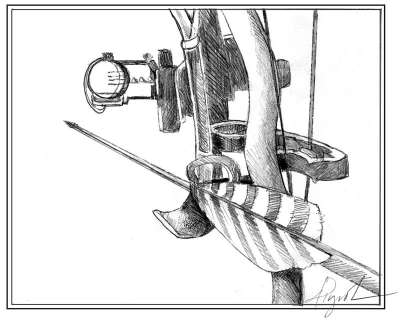
Writers love conflict, and so we often put religion and science in a small pen and make them fight, our readers standing around with fistfuls of dollars cheering one or the other on. There’s a whole professional class of fighting cocks who’ve been trained to participate in these battles – evangelicals with talk-radio megaphones who insist the earth is 10,000 years old and militant atheists with big publishing house book deals who want the world to know that they know that’s ridiculous. Whole careers are made on this.
Retrying the Scopes Monkey Trial over and over again gets boring, though. Especially when there are so many more interesting faith vs. science clashes out there, like the one going on right now in some bowhunters’ hearts and heads.
Picture a bowhunter standing in a tree stand. There’s a doe and a fawn walking toward him. At 30 yards his muscles tense. His pupils move rapidly in a way that indicates there’s a lot running through his mind.
His inner scientist is telling him to draw the bow and let the arrow fly. He’s here to procure food; also, to help manage the deer population. He knows that the state closely monitors the herd and the land’s biological carrying capacity and sets their management goals accordingly. There are about 130,000 deer in Vermont and 100,000 in New Hampshire. Densities vary – anywhere from 1 to 40 per square mile. A grown deer can eat around 2,000 pounds of plant material a year; at about 20 per square mile, they start to alter forest composition. Wildflowers like trillium start to disappear. The forest understory, and the animals that make their home there, start to disappear. Deer-favored tree species like maple and oak start to disappear and are replaced by deer-shunned species like black birch and beech. The whole forest changes. He knows that the state is counting on him to not just shoot a deer, but to shoot a doe. Bucks are far ranging and promiscuous, which from a herd-management perspective makes them largely expendable. One buck can breed most, or even all, of the receptive does in a square mile, so unless you shoot every one, which won’t happen in a regulated hunting scenario, the overall herd is going to multiply unless you cull does.
The doe stops at 20 yards to browse, turns and presents a quartering-away shot. He brings the bow to a full draw and puts the site pin behind her shoulder.
And yet. His inner spiritual voice is telling him to let the doe walk. He was raised to shoot bucks. “You don’t shoot the mothers,” that’s what his father taught him, whose father taught him, whose father was old enough to remember the “if it’s brown, it’s down” days when farmers and market hunters literally wiped deer out of the region. Yes, we’ve learned a lot since then, but it doesn’t mean that today’s hunters don’t carry these psychic scars. Plus the deer’s with a fawn, and who can shrug that off completely? Emotionally speaking, it’s relatively easy to shoot a buck because they’re ghosts – they appear all sexed up for fleeting moments and either end up on your meatpole or fade back into the ether never to be seen again. But you get to know doe/fawn groups. You watch the fawns frolicking at the edge of the meadow in July under mom’s watchful eye. You see them slinking across the road at dusk as you drive to town and flash your headlights at the next car you see, worried for their safety. Plus, the hunter knows that while the state’s numbers are likely good in a landscape sense, population density gets more difficult to pin down at ground level. Hunting pressure, food, development, posted signs concentrate deer. He’s not so sure there are too many deer on this particular ridge. And frankly, he gets a little bent hearing biologists and timberland owners telling him to kill as many deer as he can. This life and death moment is between him and the deer; he doesn’t like to be made to feel like a contract killer.
I’m of the perspective, to steal a phrase from the late Stephen Jay Gould, that faith and science are non-overlapping magisterial. That science is beautiful because it seeks to establish facts, and religion is beautiful because it seeks to establish moral codes and inner peace. I love that humanity is complex enough to pursue both.
See the hunter’s finger resting on the bow’s trigger. I’m of the perspective that whichever decision he makes will be a sound one.


Discussion *